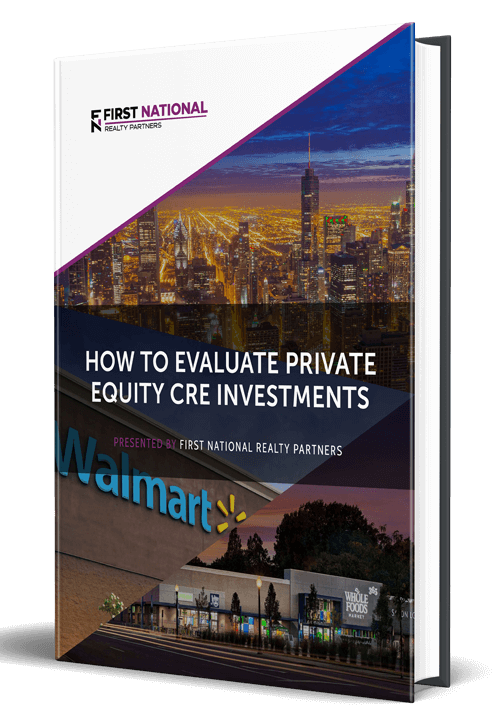In commercial real estate investing, the internal rate of return (IRR) and the equity multiple are two of the most commonly used metrics for measuring investment returns. While they are both used to measure profitability, IRR and the equity multiple are calculated very differently and can tell conflicting stories about the property’s performance.
In this article, we are going to discuss both the internal rate of return and the equity multiple. We will define what they are, how they are calculated, and why they can be misleading when reviewed in isolation. By the end, readers will be able to calculate these metrics on their own as part of their CRE investment due diligence process.
At First National Realty Partners, we always use the IRR and Equity Multiple when evaluating a potential property purchase. While they are a good indicator of potential returns, we also use them as a way to screen for the most profitable deals, which are the ones we present to our investors. To learn more about our current investment opportunities, click here.
What is Private Equity Real Estate?
A private equity firm is a specialized type of investment company that invests in the equity of other firms, including those that own commercial real estate. Real estate private equity firms offer different types of investments that can provide high net worth individuals/accredited investors with portfolio diversification through different property types (multifamily, office buildings, industrial properties, retail properties), different investment strategies, and different real estate markets.
What Sort of Returns Does Private Equity Real Estate Offer?
Depending on the type of deal, private equity investors can typically expect annual returns in the 5% – 20% range. For example, core and core-plus real estate assets tend to be at the safer end of the risk spectrum so they may offer a lower return in the 5% – 10% range. At the other end of the risk/return spectrum, value-add and opportunistic deals offer higher returns, usually in the 10% – 20% range annually.
However, it is important to note that these returns can vary widely by deal, investment manager, investment vehicle, and location. It is always important to read the deal’s offering documents and to complete your own due diligence before committing any investment funds.
When quoting potential private equity investment returns for commercial properties, there are two metrics that fund managers/institutional investors commonly use: IRR and equity multiple.
What is the Internal Rate of Return (IRR)?
IRR is the rate of return earned on each dollar invested, for each period of time it is invested in.
How is IRR Calculated?
Mathematically, IRR is calculated as the discount rate that sets the Net Present Value of all future cash flows (positive or negative) equal to zero. Manually, the formula used to calculate IRR can be complex so it is usually calculated using the “IRR” function and projected cash flows in a spreadsheet program.
Benefits of Using IRR
As a tool for measuring returns, there are two benefits of using IRR.
The first is that it accounts for the Time Value of Money, which is the idea that a dollar today is worth more than a dollar in the future due to its ability to be reinvested and earn interest. If an investment returns the same amount of money over two different time periods, the one with the shorter duration will have the higher IRR.
The second benefit is that IRR allows for the comparison of one investment to another as long as they have the same hold period. This includes comparing two real estate investments or comparing a real estate investment to one in another asset class like the stock market, real estate investment trusts (REITs), or bonds.
Drawbacks of Using IRR
IRR cannot be used to compare projects with different holding periods. For example, if an investor is comparing one project with a 5 year holding period to another one with a 10 year holding period, IRR is useless.
In addition, IRR doesn’t measure the absolute return on an investment. A $100,000 investment that returns $105,000 in one month (return of $100,000 in principal and $5,000 in earnings) has an IRR of ~80%, which seems fantastic, but in reality the real estate investor has only made 5% of their initial investment back.
To measure the absolute return, the equity multiple is a better option.
What is the Equity Multiple?
Like IRR, the equity multiple is a real estate industry performance metric that measures the ratio of cash received to cash invested.
How is Equity Multiple Calculated?
The equity multiple is calculated as an investment’s total cash flows received divided by the original investment. For example, a project returns $150,000 on an investment of $100,000, it has an equity multiple of 1.5X.
Benefits of Using Equity Multiple To Measure Returns
The primary benefit of using the equity multiple to measure returns is that it compensates for one of IRR’s greatest weaknesses: it does measure absolute returns. Using the same example above, the resulting equity multiple of 1.5X indicates that the investor has earned a total of $50,000 on their original investment.
Drawbacks of Using Equity Multiple To Measure Returns
But, the major limitation to using the equity multiple is that there is no accounting for the amount of time it takes to earn the return. In the example above, it could take 1 year or 30 years to earn the $50,000 and the equity multiple would still be 1.5X
IRR vs. Equity Multiple, Which is Better to Use?
When measuring investment returns, the truth is, neither IRR or equity multiple is an objectively “better” metric. They each serve a different purpose. The best use of these metrics is together because they’re complementary to each other. IRR accounts for the time it takes to earn the return while the equity multiple indicates how much an investment returns on an absolute basis.
Example 1: Two Properties with Similar Cash Flows
To illustrate how IRR and equity multiple can complement one another, consider the following example of two projects with similar cash flows. Which one has the higher IRR?

If you guessed Investment #1, you are correct. It has an IRR of ~13.82% while Investment #2 has an IRR of 12.63%. It’s because the $250M distribution occurs earlier in the holding period. Remember, the Time Value of Money concept skews IRR higher when the larger returns occur earlier in the holding period (because they have time to compound) or when the holding period is shorter (because the return happens faster).
Because the cash flows are the same for each Investment, the equity multiple is also going to be the same at 1.65X. So, given the same equity multiple, Investment #1 may be the better project because it has a higher IRR.
Example 2: Two Properties with Different Equity Multiples
But, the equity multiple isn’t always the same, which can make a comparison between two investments slightly more difficult. To illustrate this point, let’s look at another example of two investment opportunities:

In this example, Investment #1 has an IRR of ~19.71% while Investment #2 has an IRR of ~16.37%, so it’s the better investment, right? Not necessarily.
The equity multiple for Investment #1 is 1.85X while the equity multiple for Investment #2 is 1.90X. So, despite the lower IRR, Investment #2 may be the better project because it actually has a better total return on an absolute basis over the same time period.
Takeaway When Considering IRR vs. Equity Multiple
The broader point is this, when evaluating a commercial real estate investment, it’s a best practice to look at returns from multiple angles and with multiple measurement tools to determine which opportunity is best. IRR works well when comparing investments with similar holding periods because it incorporates the Time Value of Money. However, it does a poor job of defining an investment’s absolute return. Conversely, the equity multiple does a great job of measuring the absolute return, but a poor job of accounting for how long it takes to achieve it.
Conclusions & Summary
- A private equity firm is a specialized type of investment company that invests in the equity of other companies, including those that own real estate.
- To provide an indication of the potential profitability of an investment, two popular metrics are commonly used, IRR and equity multiple.
- IRR is the rate of return earned on each dollar invested, for each time period it is invested in.
- The benefit of using IRR is that it accounts for the time value of money, but the downside is that it does not measure the absolute return on an investment.
- Equity multiple is the ratio of total cash received to total cash invested.
- The benefit of using the equity multiple is that it does measure the absolute return on an investment, but the downside is that there is no indication of how long it took to earn it.
- Neither metric is better than the other. Instead they should be used together as part of a complete investment due diligence program.
Interested In Learning More?
First National Realty Partners is one of the country’s leading private equity commercial real estate investment firms. With an intentional focus on finding world-class, multi-tenanted assets well below intrinsic value, we seek to create superior long-term, risk-adjusted returns for our investors while creating strong economic assets for the communities we invest in.
When evaluating our potential deals, we use both IRR and Equity Multiple, in addition to a variety of other metrics to determine the best projects for our investors. If you’d like to learn more about our investment opportunities, contact us at (800) 605-4966 or info@fnrpusa.com for more information.






